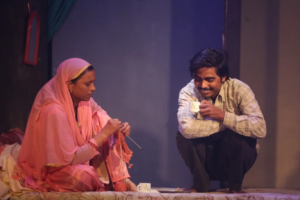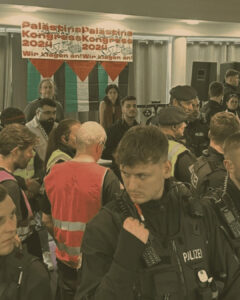
Our world ended many times over: The ongoing demolitions deepen the humanitarian crisis in Khori Gaon
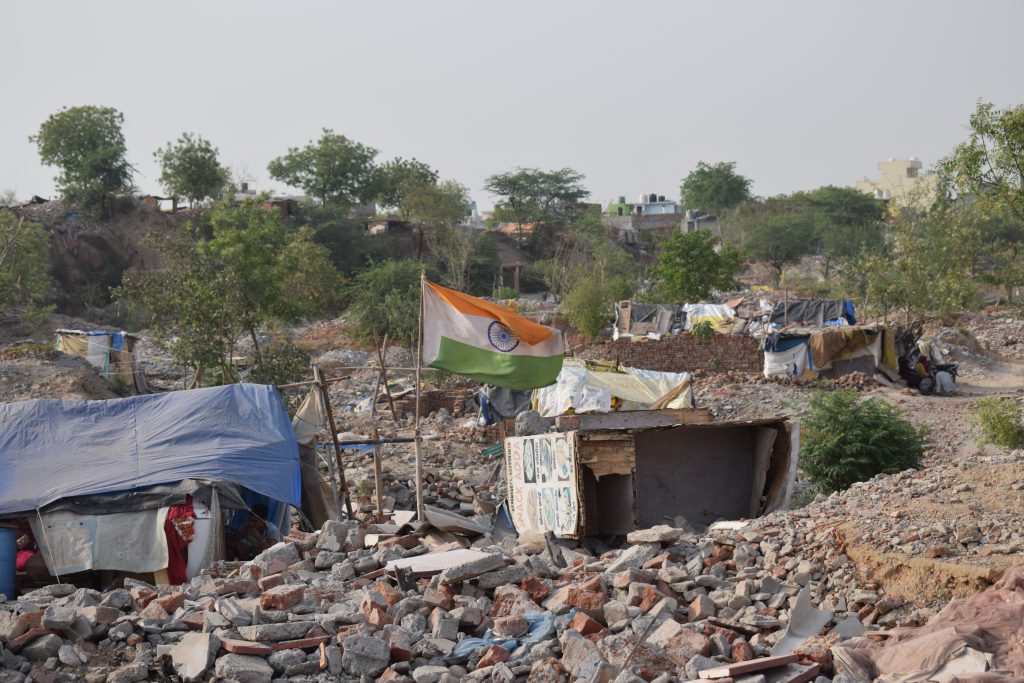
In this essay, Sukanya Roy sheds light on the plight of the residents of Khori Gaon in light of the demolition orders.
“All the belongings I have now are what my little boy could pull out from the rubble with his bare hands,” said Poonam Devi (name changed, 35) pointing to the nearly empty shelves in her rented room in Lal Kuan, an informal settlement at the edge of Delhi. Her son Akash (name changed, 10) was making tea and dinner after she had come back from a long day working as a daily-wage laborer.
Poonam, who builds houses for others, found her own house in Khori Gaon demolished in July 2021. “The bulldozer had razed down the neighbor’s house, it was my turn next.” The Faridabad Police arrested her while she was protesting the demolition of her house and took her to the Faridabad Police Station. Akash didn’t know what to go after – his house or his mother. He lived amidst the rubble for four days, shivered in the rain, not knowing where his mother was. “After my husband died six years ago, I’ve been the sole earner for both of us,” she added.
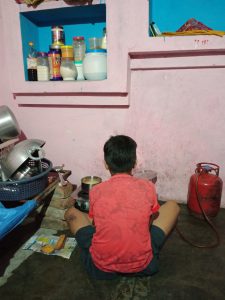
Poonam’s helplessness was not hers alone. On 7 June 2021, India’s Supreme Court (SC) upheld its existing order to demolish the houses of at least 10,000 families in Khori Gaon, a 120-acre informal working class settlement located on the Delhi-Haryana border at the foothills of the Aravalli Mountain range. This sounded a death knell on the lives of at least 100,000 residents – including 20,000 children and at least 5,000 pregnant and lactating women, who were rendered homeless. The demolition took place on 9 June – a day when India recorded 93,463 new COVID-19 cases. Divya Masih (name changed, 41), a resident of Khori Gaon, told me: “Modi was asking people to stay home and stay safe during the pandemic. How could we stay safe if we didn’t have a home?”
The SC ordered the Municipal Corporation of Faridabad (MCF) to not use the COVID pandemic as an “excuse” to delay the demolition of Khori Gaon. The Haryana State Government and the Faridabad Police were instructed to provide necessary cooperation to the MCF to evict the residents or “forest encroachers” as they called them. In the SC hearing on 29 March, Justice A.M. Khanwilkar observed: “Environment is more important than your civil rights. Your civil rights are subordinate to the environment.”
Demolitions in Khori Gaon started in September 2020 and continued till January 2022. Some houses and shanties erected from the rubbles by those who had nowhere else to go were torn down at least five times, said Vimal Bhai, a social and environmental activist working for the welfare of evicted Khori Gaon residents.
A report titled “Homeless, Starving, and Nowhere to Go” was published by the Concerned Citizens of Khori Gaon and the National Alliance of People’s Movement (NAPM) in July 2021. It noted that during the demolition in July, the “police used drones to locate where residents had gathered and used force to disperse them.” They also stopped food supplies, water and medical aid from reaching the affected residents. Section 144 of the Indian Penal Code (IPC), prohibiting unlawful assembly of more than four people, was invoked in Khori Gaon and nine people, including three women, were arrested for protesting the demolition of their houses. Divya Masih was arrested on this charge: “When I was released from jail, I kept looking for my house, as if it was a button I had dropped – that’s how badly they tore it down.”
UN Special Rapporteurs took note of these human rights violations and asked “India to respect its own laws […] of eliminating homelessness by 2022 [… and] to urgently review its plans for razing Khori Gaon […] so as to not leave anyone homeless.” They also highlighted that the role of the Supreme Court was to interpret laws in the light of internationally recognized human rights standards and not to undermine them.
In the NAPM report, the testimony of one Khori Gaon resident about the demolitions reads: “[…] we didn’t get their [SC and MCF] game plan then, we are understanding it now.” This “game plan” of laying claim over Khori Gaon by the State and allied parties has caused irreparable damage to the residents, who have been fighting a lonely battle with their homes destroyed by the MCF and the Haryana Forest Department and injustice served to them by the Supreme Court.
Khori Gaon started developing as a post-quarrying landscape in the 1970s and some of the earliest residents were migrant laborers with their families. In 1992, the SC issued a complete ban on mining activities to stop environmental degradation of the Aravallis and notified almost 2 million hectares (39.35 per cent of Haryana’s total area) under Sections 3, 4 and 5 of the Punjab Land Preservation Act (PLPA), 1900.
The PLPA is a colonial law regulating land use with a special focus on soil and water conservation. Khori Gaon falls under notified PLPA land in the Aravalli region. In 2004, the SC deemed all lands falling under Section 4 of the PLPA as “forest land.” However, people had been settling into Khori Gaon even before the Forest Conservation Act was passed in 1980 and they continued to settle after 1992 as a burgeoning land mafia sold off plots to working class families. The NAPM report notes that since 2005, the Haryana Forest Department has been terming Khori Gaon residents as “forest encroachers” and issuing notices for their eviction.
While the Supreme Court justified that Khori Gaon had to be demolished to conserve “forest land,” the classification of whether PLPA land is forest land has been debated after the demolition, as noted in the third clause of the latest SC order.
“The Haryana Government never put up any clear signs that Khori Gaon was forest land. How will a poor population, whose main concern is earning their daily bread, be aware of a Supreme Court ruling? It’s the State’s duty to inform them,” said Vimal Bhai.
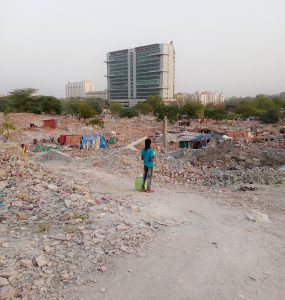
The Haryana Government went one step further than concealing crucial information: it actively profited from the land mafia settling people into Khori Gaon. The NAPM report noted that many residents were provided fake property documents and power of attorney for the land by brokers and land mafia. Faridabad Police and the Haryana Forest Department extorted big sums of money from locals each time they tried to add floors and rooms to their houses. Reena Devi (39) corroborated this by sharing her own experience with the Police: “I had to bribe the Police when I replaced the tin roof of my house with a pakka roof. They threatened to damage my house unless we paid up so my husband and I pleaded with them – saying this is all the money we can offer you. [They] took it and left.”
Promila Mondal (56), an evictee who works as house help in a gated society located a kilometer from Khori Gaon, said: “We are not encroachers, we bought our plot ten years ago. No one told us this land is off-limits then. We have been tricked, destroyed.” Mondal feels that her life, even before the demolition, has been a tally of losses. Orphaned at a young age, she has never had a house to call her own. “The Khori Gaon home was my first spark of hope, my first home built with blood and sweat. Even that has turned to dust now.”
The situation in Khori Gaon is further complicated by the Delhi-Haryana border ambiguity. Khori Gaon is situated in Haryana, whereas the neighboring Lal Kuan settlement is located in Delhi. However, there has never been a clear border between the two states in this area except for a 2-feet-high wiring installed around Lal Kuan after Khori Gaon was demolished. The residents of Khori Gaon never knew they were living on disputed land – they were assured that Khori Gaon was in Delhi and Sahi Ram Pahalwan, an MLA from the Aam Aadmi Party, provided them with Voter ID cards that mentioned their place of residence as Delhi instead of Haryana. The Delhi government also supplied electricity to newer parts of Khori Gaon through informal channels and built roads as well. According to Saroj Paswan (45), a resident of Khori Gaon since 2002, “this was done to garner votes from us. If they [politicians] know which is Delhi and which is Haryana, why give us incorrect documents? We were settled in by one state [Delhi] and are displaced now by another [Haryana]. Both are concerned with their selfish ends.”
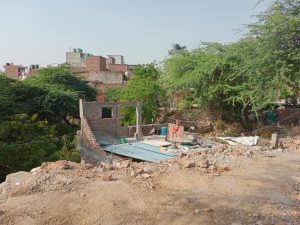
In its faulty implementation of the PLPA order, Haryana proved to be biased against the urban poor. Khori Gaon is not the only settlement on PLPA land; there are also farmhouses built by the Delhi and Haryana elite, posh hotels and hospitality establishments, corporate business towers, the religious establishment Radha Soami Satsang Bhavan and the Surajkund tourist complex. A 2020 report submitted by the Haryana Forest Department to the National Green Tribunal noted that 129 illegally constructed sites stood on PLPA land in Faridabad district. As of October 2021, apart from Khori Gaon, MCF demolished merely nine out of 129 structures.
Ishita Chatterjee, a researcher at the University of Melbourne who has been studying Khori Gaon since 2017 as part of her PhD thesis, told me that “the Haryana Government’s eagerness to demolish Khori Gaon was probably not connected with protecting PLPA land nor forest conservation. Their aim was to get rid of the poor and use the land differently. This became evident when they created a parking space there for the Surajkund Fair.”
In March and April 2022, the Haryana Government hosted the Surajkund Fair, a yearly tourism event at the Surajkund Tourist Complex and the rubbles from adjacent Khori Gaon were cleared to make space for car parking. The Government’s action did not reflect the principle of forest conservation, which was upheld while demolishing Khori Gaon. The Haryana State has repeatedly sought to use PLPA land “differently,” that is for commercial ends. In 2018, it passed an amendment to the Act that would allow large scale constructions to proliferate on PLPA land when the SC ruled to demolish an elite residential enclave. Then, in March 2021, it appealed to the SC to allow mining to be resumed in the Aravalli Hills.
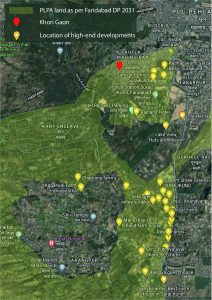
Seema Devi (35) lives now in a shanty close to the parking space where her house once was. “Do not forget that the fairs of the rich are standing on the land strewn with our bones. My husband suffered a heart attack after our house was demolished. He couldn’t withstand the shock. He died right there…” There are reports of people taking their lives since the announcement of the demolitions in Khori Gaon. Vimla (46) consoled Seema and added: “My son died of shock as well.” She pointed towards the Taj Hotel separated from the rubble of Khori Gaon by a small boundary wall and said: “The MCF couldn’t see such a big building encroaching on forest land, but managed to see our small houses. If you want to save forest land, break down every building. Should we have no rights because we’re poor?”
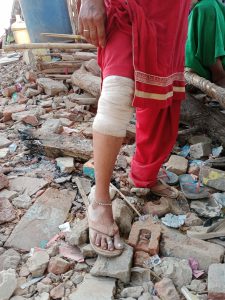
Seema and Vimla, along with three other women who have all lost their husbands or sons, have banded together and live as a group amidst the rubble. “At night we sleep on cots placed close by, open to the elements and wild animals. We have been harassed by drunkards and passersby. It’s really scary to sleep out in the open,” said Chameli Devi (63), who has been living in Khori Gaon for 45 years. While these women find strength in companionship, they worry about their daughters and daughters-in-law. “We have nowhere to take them if they fall sick. They take baths and defecate in the open, cannot attend school because there’s no electricity to study at home,” said Sunehri (50), a single mother of two girls, who doesn’t earn enough to rent an accommodation. She taunted the tagline Beti Bachao, Beti Padhao [Save daughters, educate daughters] of a much-publicized Central Government scheme: “Are our daughters not worth saving?”
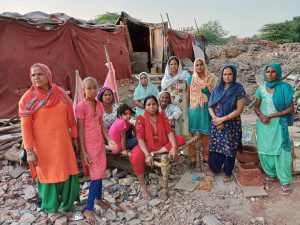
On 13 July 2021, the MCF announced that it would be allotting Economically Weaker Section (EWS) flats in Dabua Colony for the evicted residents of Khori Gaon. Within 24 hours of the announcement, it began the most brutal spate of demolitions Khori Gaon had ever witnessed.
Residents were not given adequate notice to clear out their belongings and find rented accommodation. Farzana (34) was at her native village in Bihar during the lockdown in July as her husband couldn’t earn enough as an autorickshaw driver in Delhi. She returned to Khori Gaon on 10 July, after her friend’s house was demolished in June. “There were fewer trains running at the time and it took me nearly a month to get tickets for my family,” she explained. Farzana was unable to find a flat in time and the bulldozers came and mowed down her house. “I had started stitching clothes to earn extra money and three sewing machines were destroyed. At the time, we had neither a roof over our heads nor the ability to feed our children.” She is not eligible for rehabilitation in the EWS flats in Dabua Colony, as they come with a precondition. Evictees need to prove that they lived in Haryana through their Haryana voter ID cards, Haryana Parivar Pehchan Patra (family ID) cards (PPP) or an electricity bill issued by the Haryana Electricity Board. While some residents, especially from Old Khori Gaon have Haryana Voter IDs, a large number of newer residents like Farzana have been provided Delhi voter IDs while others have no documentation at all. Another catch is that rehabilitation is extended only to those residents whose PPP cards were issued prior to January 2021, even though the PPP scheme was launched by the Haryana Government in August 2020. “Five months is just not enough for such a large working-class population to suddenly acquaint themselves with a new scheme. They were in no hurry – they didn’t dream that their houses would be demolished. Now their futures rely on this card,” Vimal Bhai explained.
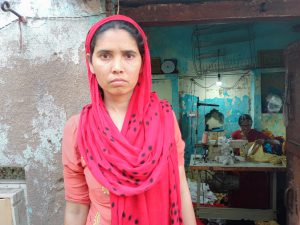
Senior Advocate Arun Bharadwaj, representing the MCF, told the SC in the 31 March hearing that 1,027 families were eligible for the EWS flats and that 403 out of at least 10,000 families had received a promised monthly sum of Rs 2,000 for six months since August 2021. This means that over 96 percent of evicted families have received no monetary support after the demolitions. “The MCF has no idea how many families they rendered homeless or how many people need support because they didn’t carry out a ground survey before demolition,” Vimal Bhai said.
As for the EWS flats, a group of residents who found their names in the provisional allotment list went to survey the flats they had been assigned and found pigs roaming in the compound, windows and doors missing, toilets broken and clogged and rooms in dire conditions. “We are asked to pay Rs. 377,500 for these flats. Why should we pay to buy this mess, after our homes have been demolished?” asked Paswan.
The latest data about families eligible for rehabilitation has come down to 1,009, as the MCF couldn’t verify the documents of 18 people. On 30 April, the MCF started giving out possession letters for the flats, which can only be handed over after their conditions are certified by an expert committee in the upcoming court hearing.
Rajeev Singh (65) used to work as a security guard in Delhi and has been living in Khori Gaon for 25 years: four generations of his family have lived in a house that has now been demolished. “I never knew that such misery would befall me in my old age. I had just had the second operation for my knee when they tore down my house. I was in immense pain and limped outside, otherwise they would have bulldozed me as well.” His family has been able to afford a rented flat nearby as his son has a stable income.
Payal Yadav (32) lost her means of livelihood along with her house. Yadav belongs to the Kinnar community – a term for self-identification used by several transgender and intersex people in India. She was excommunicated by her guru (the leader of her social group) when she asked for financial help and can no longer engage in badhaai, the traditional blessing work. She also faced discrimination while searching for flats to rent due to the stigma attached to the lives and livelihoods of Kinnar community. “I don’t care about the stigma – that’s still better than having no work,” said Yadav. She feels suffocated in her rented flat and spends most of her days sorting through the rubble of her demolished house collecting bricks. “I’m saving them for the day when I can re-build my house here.”
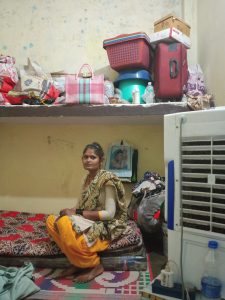
Mohammed Hadees Andari (52) does not have money to rent even the cheapest room nearby, which would cost him about Rs. 2,000 per month. He did not receive the solatium promised by the MCF and neither did any of the people interviewed for this story. Ansari continues to live amidst the rubbles and sleeps under a tarpaulin on a cot he managed to pull out of the debris of his home. “They broke not only my house, but also the cart on which I used to sell vegetables,” he said. Now, he sells the bricks of his house, at 1 rupee per brick, to buy rotis and milk to feed himself and his pet goat Munni. The MCF has bulldozed not only his house, but each of the three shanties he built since July 2021. “It’s exhausting to start from scratch every time… [they should] just kill us in one blow,” he sighed.
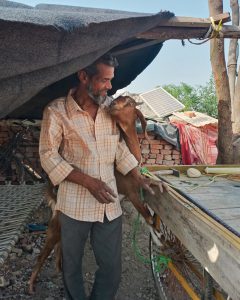
The urban poor who gradually settled down in Khori Gaon are subject to the multiple marginalities of class and caste. Myopic arguments to conserve the environment ignore the rights of the people who have been pushed to the fringes of booming cities due to the failure of both Delhi and Haryana governments to provide them with affordable housing.
“When the earliest of us moved in, the land was almost uninhabitable, filled with potholes, uneven and totally barren. We planted trees, built our houses brick by brick, made this place beautiful and livable. Now the government wants the land back! They should’ve taken it when it was worth in dirt, and not in gold,” Paswan said. By tearing down Khori Gaon, the SC denied their history: a history that is repeatedly rewritten through spates of demolitions. On 21 April 2022, six MCF bulldozers and a Police bus arrived at Khori Gaon. By midday, bulldozers were tearing down the shanties of people who were neither eligible for rehabilitation nor could afford to rent accommodation. Arshad Ali (26), who witnessed the demolition, said that “they were also pouring rubble to block the pathways through which people could leave and enter their shanties. No one knows what will happen next.”
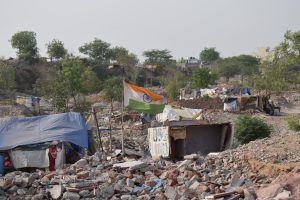
Reena Devi and her husband Ajeet Bhaitha (42), who were earlier extorted by the Police in return for the promise of security, have now to pay off loans for a house that no longer exists. Bhaitha has been working night shifts with higher pay at a garment factory for three years so their informal loans could be paid back faster. “All that hard work was fine, at least I had a house to call my own. The demolition has set us back at least 20 years. Except, it’s worse now, as we have children to fend for.”
Their daughter Muskan Kumari (18) started studying Arts in 2021. Her talents include singing and dancing and showed me photos of the accolades she won in these fields. However, the photos stopped abruptly in July 2021. Since then, her phone’s gallery only has photos and videos of demolitions, bulldozers and meetings organized to strengthen the ground level resistance of Khori Gaon. Since 27 April 2022, a sizeable Police force has been supervising ongoing demolitions in Khori Gaon. Through its latest order, the SC has again welcomed the Police presence by ruling that the MCF may request it whenever necessary for “security reasons.” Muskan reflected: “They won’t spare either Khori Gaon or us, so it’s time for a different dream now. I want to become a video journalist and show the world that Khori Gaon deserves justice.”


